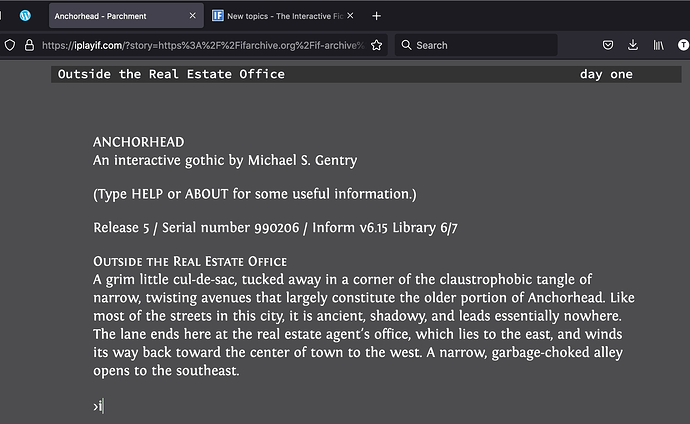I’ve been seeing people singing the praises of Vorple and saying adding graphics, sound effects, and UI elements to parser interactive fiction is the future and will make parser IF more fun/accessible for people, so I’ve been considering switching to TADS 3 Web UI a lot lately, so that I can craft a cohesive themed experience for my text adventure, with custom text styling, ambient background sounds, background images, hyperlinks to examine objects, buttons to do various actions, an automatic map, character portraits, etc. Like what Vorple does for Inform.
However, the more I think about it, the less I feel like graphics and UI elements really do anything to enhance parser IF artistically, or increase its accessibility to people who wouldn’t otherwise be interested in the medium. I’m not sure what images really add to text descriptions, for instance, except for ruining the reader’s freedom to fill in the blanks of a description and imagine things how they want to, subtly contradicting or distracting from the text, and/or replacing text that can communicate far more about atmosphere and themes and subtext than a picture can. (A thousand words are worth ten-thousand pictures, or about 40 seconds of video!). Sound effects I sort of get. As for adding UI elements, I don’t think adding action buttons, or a menu of options for actions based on what objects you select, or making object names clickable to inspect them, really adds much either. Those UI elements are entirely superfluous add-ons, peripheral to the core game mechanics and interaction loop of parser IF, which doesn’t change, so if someone already isn’t interested in parser interactive fiction, I can’t help but feel that it won’t fundamentally change anything for them. It feels like all of these changes are just set dressing that fails to either improve the medium for those who like it, or make it actually, practically more accessible to those who don’t.
The other thing is, one of the magical parts of parser interactive fiction is that you need a much smaller set of skills, and a much smaller investment of time and resources, to produce a parser interactive fiction game than a graphical video game of a similar size and detail. This frees parser interactive fiction authors to be far more ambitious than they could otherwise be in another medium, and enables them to work alone to produce ambitious works. Adding on all this other stuff detracts from that substantially.
Additionally, speaking of accessibility, isn’t the fact that parser IF is basically presentation-agnostic, so the player can choose for themselves how things look, from font and font size to foreground and background colors, a huge benefit? It means people can choose what’s legible for them, which is great for visually impaired people and people who struggle with eye strain or visual processing problems. It’s kind of nice that parser IF works like ebooks, you know?
Anyway, am I missing something here?
Edit: this is not meant to come off hostile to those who use/like Vorple, I just write that way >.<
